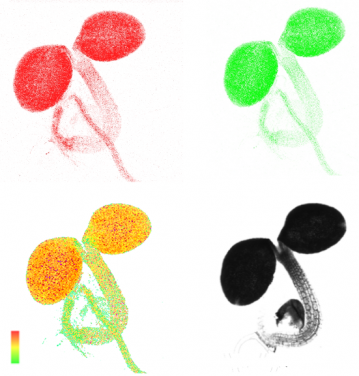Media
An HKU-led team of international plant scientists
reveal how chloroplasts maintain energy efficiency
24 Oct 2018

Live images of a plastid-localized ATP sensor in an Arabidopsis seedling.
Red and green panels show the images of the ATP sensor at 470 nm – 507 nm and 526 nm – 545 nm in a 3-day-old seedling. The ratio between both images, which corresponds to ATP concentration (higher level in red and lower level in green), is shown in the lower left panel. The lower right panel is the brightfield image of the seedling. (Photo credit:
Chia Pao Voon)
Photosynthesis is the most important energy-harvesting process on our planet, and Adenosine triphosphate (ATP) plays a crucial role here – it provides the energy needed for carbon fixation. A team of researchers from Hong Kong, Germany, Sweden, and the US, used a fluorescent protein sensor in a model plant (Arabidopsis thaliana) to detect ATP levels in chloroplasts and the cytosol in real-time. Their observations indicate that although the chloroplast is the key energy harvester and producer in a plant cell, its demand for ATP is also extremely high. Their findings were published recently in the journal Proceedings of the National Academy of Sciences of the United States of America (PNAS).
This research observes that mature plant chloroplasts manage their ATP largely in isolation from other cellular spaces, pinpointing a strategy of plants that uses their energy efficiently. This contrasts with a previous study that showed chloroplasts in unicellular diatoms could import cytosolic ATP to support carbon fixation. “We observed that only chloroplasts of very young developing leaves could import ATP from the cytosol, whereas the rate of ATP import into mature chloroplasts was negligible, as ATP transporters on the chloroplast membrane are only expressed in the young ones,” said Chiapao Voon, a PhD student from the School of Biological Sciences of The University of Hong Kong. “This is originated from the mechanism that wasteful energy consumption by chloroplasts at night should be avoided. Though illumination can increase chloroplast ATP concentration instantly, it drops to the basal level in only 30 seconds once the illumination is withdrawn. This high energy consumption suggests the need for mature chloroplasts to formulate a strategy to maintain energy efficiency in the dark,” Voon added.
Study lead author Dr Boon Leong Lim, also from HKU School of Biological Sciences, further explicated the advantage for plants to restrict ATP import into mature chloroplasts: “We had been trying to express ATP transporters in mature leaf cells, but it turned up cytosolic ATP was exhausted by chloroplasts in the end. This explains why ATP transporters are only present in young seedlings – during their early developmental stage, young chloroplasts require exogenous ATP for biogenesis. When chloroplasts are fully developed and become self-sustainable, ATP transporters have to be downregulated so that the energy harvested in daytime would not be incontinently consumed by chloroplasts at night. Unlike unicellular diatoms, which only need to manage their own energy usage, multicellular photosynthetic organisms need to manage ATP consumption in different cell types. The primary job of mature leaf chloroplasts is to harvest energy and export sugar in the light to support the growth of the other cells, while minimising its own wasteful energy consumption in the dark”. Dr Lim continued to depict how chloroplasts obtain energy at night. “We believe that chloroplasts could obtain ATP by catabolising starch accumulated during daytime, providing minimal level of ATP for its metabolism at night’,” said Dr Lim.
Looking forward, Dr. Lim said “We found that by modulation the energy exchanges between chloroplasts and mitochondria, the abilities of sugar production by chloroplasts and ATP generation by mitochondria can be enhanced, which are able to promote plant growth. This will be the topic of my next manuscript. In the long run, we wish our works can help to tackle global warming.”
The co-authors of this article include Prof. Markus Schwarzländer of Münster University, Dr Wayne K. Versaw of Texas A&M University and Prof. Per Gardeström of Umeå University.
For press enquiry, please contact Dr Boon Lim from HKU School of Biological Sciences by email at bllim@hku.hk; or Ms Cindy Chan, Senior Manager of HKU Faculty of Science by phone at 3917-5286/ 6703-0212 or by email at cindycst@hku.hk.
Link of Journal Paper
“ATP compartmentation in plastids and cytosol of Arabidopsis thalianarevealed by fluorescent protein sensing”, PNAS, October 23, 2018
http://www.pnas.org/content/early/2018/10/22/1711497115
Image download
https://www.scifac.hku.hk/news/media?page=1
